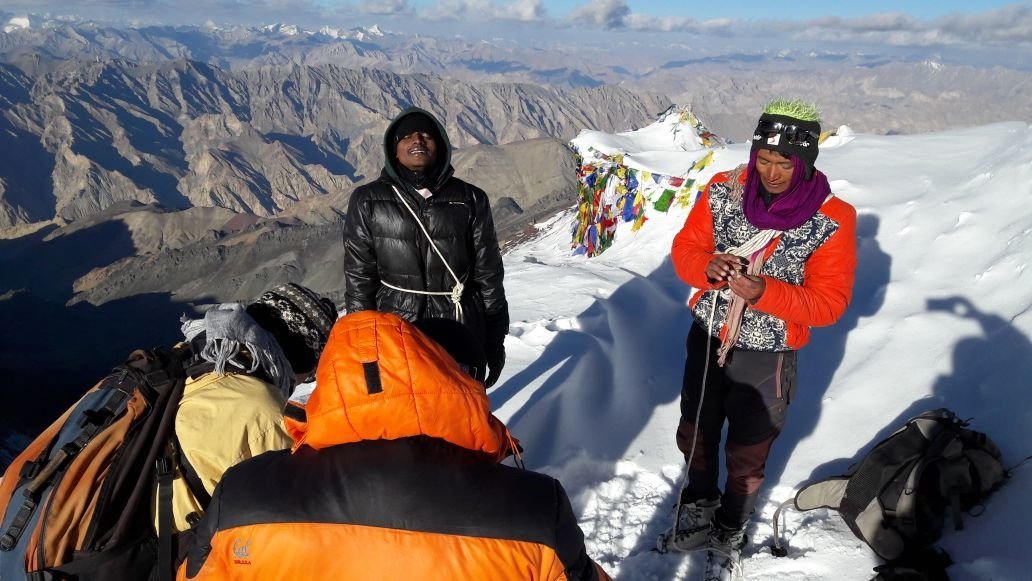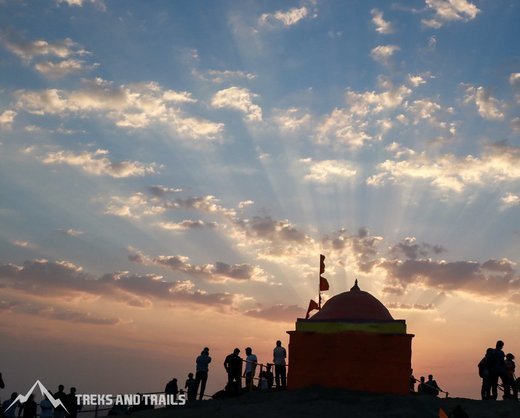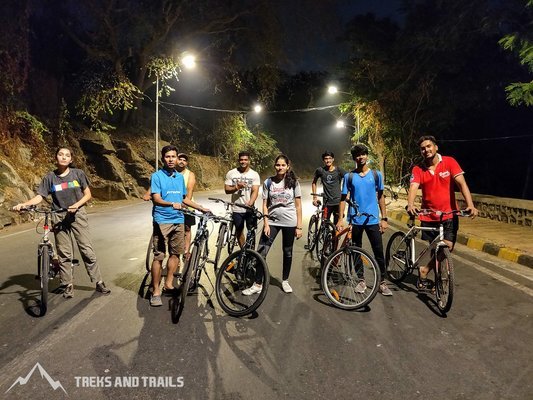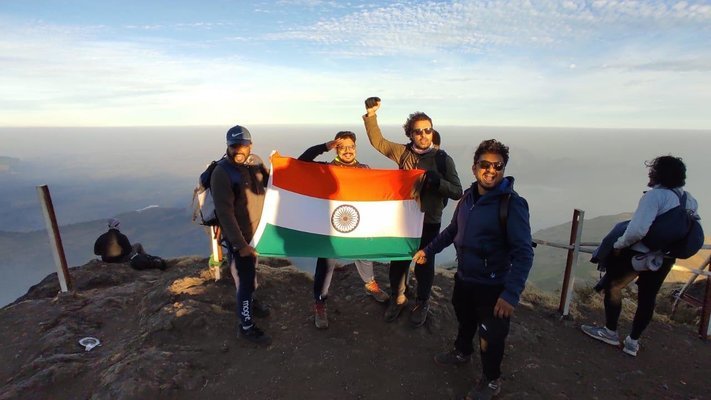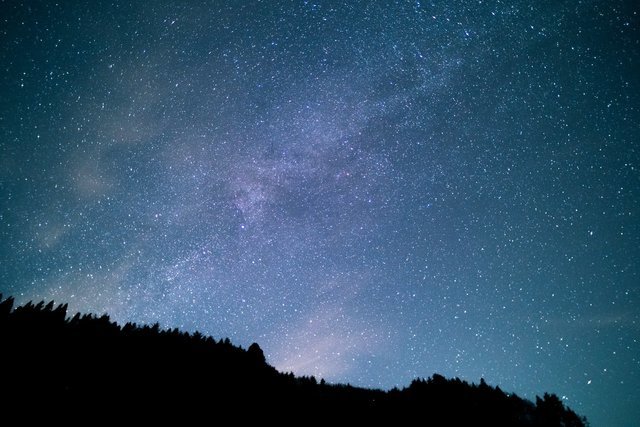About Stok Kangri
Stok Kangri 6,153 metres or 20,187 feet is the highest mountain in the Stok Range of the Himalayas in the Ladakh region of north - west India. The peak is located in Hemis National Park, 12 km southwest of the trailhead 3,610 metres or 11,844 feet in the village of Stok and around 15 km southwest of the city of Leh, the capital of Ladakh.
Despite its high altitude, Stok Kangri is a popular trekking peak and is often climbed as an initial non-technical foray into high altitude mountaineering. However, the difficulty of Stok Kangri is often underestimated and the need to acclimatise before and during the ascent makes Stok Kangri an enduring challenge.
Stok Kangri Trek Cost please email us connect@treksandtrails.org
Please Note Stok Kangri Customised and Stok Kangri Corporate Treks is available for above 8 Trekkers
Stok Kangri Trek Event Details
- Theme Trekking
- Terrain Rocky and Snow
- Nearest Town Leh
- Stok Kangri Trek Duration 9 days
- Stok Kangri Trek Grade Difficult
- Stok Kangri Height 6,153 metres
- Stok Kangri Temperature July to September 25 degree celsius to 8 Degree
Stok Kangri Trek Itinerary
Day 1 Arrival at Leh 11,480 feet
Day 2 Acclimatization day in Leh 11,480 feet
Day 3 Drive from Leh to Stok Village (11,750 ft, 1 Hrs) and Trek to Chang Ma (13,080 ft, 4 Hrs)
Day 4 Trek from Chang Ma (13,080 ft) to Manokarma (14,200 ft, 3-4 Hrs)
Day 5 Trek from Manokarma (14,200 ft) to Stok Kangri Base Camp (16,300 ft, 3-4 Hrs)
Day 6 Training Day at Base Camp
Day 7 Trek from Base Camp (16,300 ft) to MT Stok Kangri Summit (20,080 ft) and back to Base Camp (16,300 ft, 12-15 Hrs up and down)
Day 8 Trek from Stok Kangri Base Camp (16,300 ft) to Stok Village (11,750 ft, 5 Hrs) and Drive to Leh (11,480 ft) (1 Hrs). Overnight in Leh Guest House
Day 9 Departure from Leh
Detailed Stok Kangri Trek Itinerary
Day 1: Arrival at Leh (11,480 ft)
Arrive at Leh and check into the guest house and take complete rest for acclimatization.
Day 2: Acclimatization day in Leh (11,480 ft)
Leh is situated at an altitude of 11,480 ft. The entire day is for you to relax and acclimatize to the high altitude of Leh. In the evening go for a stroll in the Leh market and enjoy the cultural and natural beauty of Leh city’s barren landscape. Make most of your acclimatization day by visiting Shanti Stupa, Leh Palace and Leh Monastery. Overnight stay at Leh
Day 3: Drive from Leh to Stok Village (11,750 ft, 1 Hrs) and Trek to Chang Ma (13,080 ft, 4 Hrs)
Visit Leh Market and have breakfast at one of the famous restaurant of Leh and then we will start our drive to Stok Village (11,750 ft), the starting point of Stok Kangri Trek. The drive from Leh to Stok Village is a short one but a scenic one. We drive towards Manali Leh Highway and then take a right turn from Choglamsar towards Stok Village. Meet our trekking team at Stok Village. After the briefing session, start the trek to Chang Ma (13,080 ft). It is a fairly easy trek crossing the Stok village and the hydro powered Buddhist prayer wheel.
Day 4: Trek from Chang Ma (13,080 ft) to Manokarma (14,200 ft, 3-4 Hrs)
Ladakh’s barren landscape is out of the world and it is called as the cold desert. During today’s trek you will be crossing various water streams and if lucky you can also see blue sheep “Bharal” which come down to drink water from these streams. This part of the trekking to Stok Kangri base camp helps you the acclimatize to the high altitude.
Day 5: Trek from Manokarma (14,200 ft) to Stok Kangri Base Camp (16,300 ft, 3-4 Hrs)
After breakfast we will start the next level of Stok Kangri trek, the trek to base camp. Trek to Stok Kangri base camp is a nice place but because of the popularity of Stok Kangri trek, it’s always full house. Stok Kangri Base camp is surrounded by numerous peaks few of them are Gulap Kangri, Parcha Kangri etc.
Day 6: Training Day at Base Camp
Today is fairly relaxed day. After breakfast we will go for training to nearby glacier and we will learn how to use crampons. Climbing mountains involves lot of uncertainties. Our Trek Leader will let you know about the different situations which might occur and how to deal with them. This is also the day of relaxation, So that you gain all your strength for next day’s summit push.
Day 7: Trek from Base Camp (16,300 ft) to Mount Stok Kangri Summit (20,080 ft) and back to Base Camp (16,300 ft, 12-15 Hrs up and down)
Today is the D day of Stok Kangri Trek, we will start early in the morning in two batches, the early movers and the Pushers at 12 AM and 1 AM respectively. The Stok Kangri trek route passes the advance base camp, moraine, and glaciers and then comes the steep slope of the summit ridge full of snow. At the start of this slope wear your crampons and start the long climb. When you will be climbing this you will feel that nobody is moving from their place for hours. This climb is the test of your physical as well as mental strength. For an average trekker it takes around 9 hours to reach the Stok Kangri Summit and if you are a slow trekker then add another 3 hours. The Stok Kangri Summit gives you spectacular views the Himalayas to Karakoram.
There will be a turnaround point which you have to cross with in stipulated time to proceed further which will be communicated to you during briefing session.
Day 8: Trek from Stok Kangri Base Camp (16,300 ft) to Stok Village (11,750 ft, 5 Hrs) and Drive to Leh (11,480 ft) (1 Hrs). Overnight in Leh Guest House
The Stok Kangri trek includes high altitude trekking and mountaineering is ultimate experience would finally come to an end today at Stok Village. We will be starting early from base camp and trekking downhill all the way till Stok Village where our vehicles will be waiting for us you to transfer to guest house in Leh.
Day 9: Departure from Leh
Fly back from Leh for onward journey.
What is included in the tour
- Accommodation during Trek: Camping (Day 3 to Day 7 Night) & Guest house in Leh (Day 1, Day 2 & Day 8 Night) on sharing basis.
- Meals while on trek (Veg) from day 3rd lunch till day 8th lunch.
- Equipment’s (Tents, Sleeping Bags, Crampon & Ice Axe if required).
- First aid medical kits & Oxygen Cylinder.
- Qualified and experienced Trek Leader and support staff.
- Transport as per Itinerary.
- All fees and permits (for Indians).
What is NOT included in the tour
- IMF Fee (USD 50) (Non-Indian).
- Mineral Water & other Beverages.
- Wildlife Fee.
- Buffer Day.
- Any Kind of Expenses for Loss / Misplaced / Theft on Personal Belongings.
- Cost Incidental to Any Change in The Itinerary- Stay on Account of Train Cancellation / Ill Health / Road Blocks And / Or Any Factors Beyond Control.
- Trekking shoes in good condition.
- Energy bars, dry fruits, Flavored milk, Electrolyte drinks.
FAQ
When is the Stok Kangri Trek best time to go?
The Stok Kangri Trek best time is during the months of July, August and September. Stok Kangri trek in July the snow melts and chances of summit increases.
What is Stok Kangri Trek Difficulty Level?
Stok Kangri Trek Difficulty Level is considered by comparison a challenging high altitude trek. You need to be an experienced trekker to participate in this trek. Doing cardio vascular exercises is very helpful for preparing for this trek. Please check the preparation section to get a better understanding of this.
How much we have to trek each day?
Normally our trek are designed in such a way that we reach our camp by lunch time and on an average trekking distance is roughly 6-10 Kms each day and it takes around 6-7 hours by an average trekker to cover that distance.
Who will lead and who all will go along with us?
All our treks are led by certified & Experienced Trek Leaders/Guides. We believe in sustainable adventure eco-tourism which in effect means that our teams are locally sourced. Other than a Trek lead we in our team will have local Guides, Cook, Helpers and Porters.
How many trekkers will be in one tent?
We generally have 3-man tents were we accommodate anywhere between 2-3 people.
What level of fitness is expected from the trekkers?
Good physical fitness as well as mental fitness is required.
What is there in Food menu during a trek?
We server wholesome and nutritious Breakfast, Lunch, Dinner and Evening Snacks. The food is vegetarian. Vegetarian food is preferable at high altitudes as it is easy to digest.
Is the water on the trek safe?
The advantage of trekking the Himalayas is that your trekking route is filled with fresh Himalayan streams. Your trek leader guide will direct you to places where you can fill clean water from. We recommend this water but in case you are unsure you can carry water purifying tablets with you.

